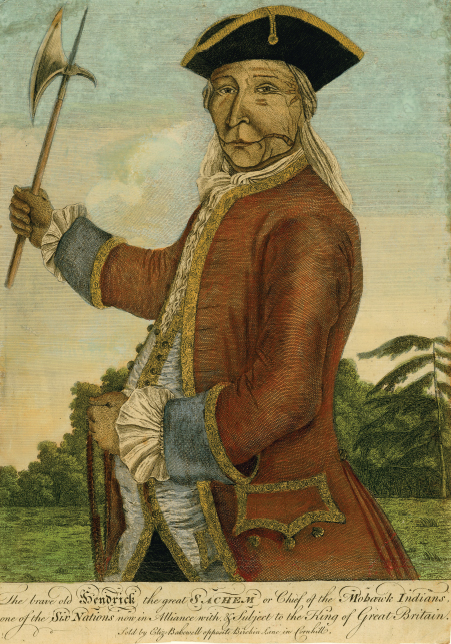America’s History: Printed Page 135
America: A Concise History: Printed Page 118
America’s History: Value Edition: Printed Page 114
The French and Indian War

In 1754, overlapping French and British claims in North America came to a head (Map 4.4). The French maintained their vast claims through a network of forts and trading posts that sustained alliances with neighboring Indians. The soft underbelly of this sprawling empire was the Ohio Valley, where French claims were tenuous. Native peoples were driven out of the valley by Iroquois attacks in the seventeenth century, but after 1720 displaced Indian populations — especially Delawares and Shawnees from Pennsylvania — resettled there in large numbers. In the 1740s, British traders from Pennsylvania began traveling down the Ohio River. They traded with Delawares and Shawnees in the upper valley and began to draw French-allied Indians into their orbit and away from French posts. Then, in 1748, the Ohio Company of Virginia, a partnership of prominent colonial planters and London merchants, received a 200,000-acre grant from the crown to establish a new settlement on the upper Ohio, threatening French claims to the region.
Conflict in the Ohio Valley By midcentury, Britain relied on the Iroquois Confederacy as its partner in Indian relations throughout the Northeast. By extending the Covenant Chain, the Iroquois had become a kind of Indian empire in their own right, claiming to speak for other groups throughout the region based on their seventeenth-century conquests. The Delawares, Shawnees, and other groups who repopulated the Ohio Valley did so in part to escape the Iroquois yoke. To maintain influence on the Ohio, the Iroquois sent two “half-kings,” Tanaghrisson (an adopted Seneca) and Scarouady (an Oneida), to the native settlement of Logstown, a trading town on the upper Ohio, where Britain recognized them as leaders.
French authorities, alarmed by British inroads, built a string of forts from Lake Erie to the headwaters of the Ohio, culminating with Fort Duquesne on the site of present-day Pittsburgh. To reassert British claims, Governor Dinwiddie dispatched an expedition led by Colonel George Washington, a twenty-two-year-old Virginian whose half-brothers were Ohio Company stockholders. Washington discovered that most of the Ohio Indians had decided to side with the French; only the Iroquois half-kings and a few of their followers supported his efforts. After Washington’s party fired on a French detachment, Tanaghrisson rushed in and killed a French officer to ensure war — a prospect that would force British arms to support Iroquois interests in the valley.

Washington’s party was soon defeated by a larger French force. The result was an international incident that prompted Virginian and British expansionists to demand war. But war in North America was a worrisome prospect: the colonies were notoriously incapable of cooperating in their own defense, and the Covenant Chain was badly in need of repair.
The Albany Congress The Iroquois Confederacy was unhappy with its British alliance and believed that the British were neglecting the Iroquois while settlers from New York pressed onto their lands. Moreover, the Ohio Indians, France, and Britain were all acting in the Ohio Valley without consulting them. To mend relations with the Iroquois, the British Board of Trade called a meeting at Albany in June 1754. There, a prominent Mohawk leader named Hendrick Peters Theyanoguin challenged Britain to defend its interests more vigorously, while Benjamin Franklin proposed a “Plan of Union” among the colonies to counter French expansion.
The Albany Plan of Union proposed that “one general government … be formed in America, including all the said colonies.” It would have created a continental assembly to manage trade, Indian policy, and the colonies’ defense. Though it was attractive to a few reform-minded colonists and administrators, the plan would have compromised the independence of colonial assemblies and the authority of Parliament. It never received serious consideration, but that did not stop the push toward war.

|
To see a longer excerpt of the Albany Plan of Union, along with other primary sources from this period, see Sources for America’s History. |
The War Hawks Win In Parliament, the fight for the Ohio prompted a debate over war with France. Henry Pelham, the British prime minister, urged calm: “There is such a load of debt, and such heavy taxes already laid upon the people, that nothing but an absolute necessity can justifie our engaging in a new War.” But two expansionist-minded war hawks — rising British statesman William Pitt and Lord Halifax, the new head of the Board of Trade — persuaded Pelham to launch an American war. In June 1755, British and New England troops captured Fort Beauséjour in the disputed territory of Nova Scotia (which the French called Acadia). Soldiers from Puritan Massachusetts then forced nearly 10,000 French settlers from their lands, arguing they were “rebels” without property rights, and deported them to France, the West Indies, and Louisiana (where “Acadians” became “Cajuns”). English and Scottish Protestants took over the farms the French Catholics left behind.
This Anglo-American triumph was quickly offset by a stunning defeat. In July 1755, General Edward Braddock advanced on Fort Duquesne with a force of 1,500 British regulars and Virginia militiamen. Braddock alienated potential allies by treating Indians (including Tanaghrisson) dismissively and denying the privilege of rank to colonial officers like George Washington. Persuaded that British arms could easily triumph in the American backcountry, he was instead routed by a French and Indian force. Braddock was killed, and more than half his troops were killed or wounded. “We have been beaten, most shamefully beaten, by a handfull of Men,” George Washington complained bitterly as he led the survivors back to Virginia.